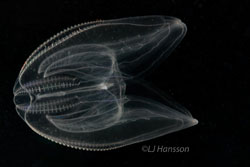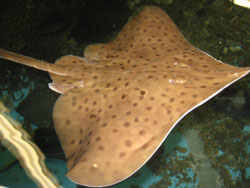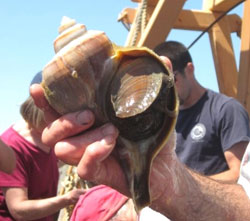 |

For further MBL News and Media Information, contact the MBL Communications Office at (508) 289-7423 or e-mail us at comm@mbl.edu
FOR IMMEDIATE RELEASE: August 11, 2008
Contact: Diana Kenney, MBL, 508-289-7139; dkenney@mbl.edu
August 2008 LabBits: A media tip sheet from the Marine Biological Laboratory
MBL, WOODS HOLE, MA—Summer on Cape Cod is synonymous with a surge of tourists, but also a surge of scientists at the MBL (Marine Biological Laboratory). For more than a century, researchers have come to the MBL each summer from around the world to immerse themselves in biological discovery. Researchers enjoy the casual, collaborative atmosphere, the access to high-tech equipment and expertise, and the escape from academic duties at their home institutions. Here is a sampling of some of the research underway this summer at the MBL’s Whitman Center for Visiting Research.
IN THIS ISSUE:
|
 |
 |
|
The warty comb jelly, Mnemiopsis ledyi, is a voracious carnivore, competing with fish for small crustaceans and zooplankton in the European seas. (Credit: Lars Johan Hansson) Full size image
Watch the Video: Using its cilia to change the water current, a warty comb jelly attempts to draw its prey, a copepod, into its mouth.
|
Invasion of the Comb Jellies
In the waters surrounding Woods Hole, Massachusetts, the warty comb jelly, Mnemiopsis ledyi, lives out its days, bumping against eel grass and collecting small crustaceans with its sticky tentacles. The delicate creature, which resembles a small jellyfish without the stinger, is just another member of the food web here on the Western Atlantic coast.
Across the ocean is a different story. Accidentally introduced to the Black Sea in the early 1980s, the warty comb jelly spread rapidly through the Caspian Sea in the 1990s and has most recently invaded the Baltic Sea. In Europe, M. ledyi is considered a voracious predator, easily snatching dinner from local fish. Countries surrounding the Baltic Sea are now concerned what’s going to happen to their waters.
“Their impact seems to be increasing and that’s been tied to warming water temperatures, giving them an ecological advantage,” says Sean Colin, assistant professor of biology at Roger Williams University. He and John Costello, professor of biology at Providence College, are at the MBL this summer to determine who and how much M. ledyi eats.
Comb jellies are unique in how they process food. Eight rows of brush-like cilia beat against the water, creating a current that brings prey closer to the mouth. Using high-speed video, the team is observing their feeding behavior, predator and prey interactions, as well as the hydrodynamics of how they swim. “This will help us to understand on which types of ecosystems they might have a large impact or small impact and under which conditions they are going to be able to thrive,” Colin says.
Comb jellies aren’t all bad news. Also at the MBL this summer is Anthony Moss, an associate professor of biology at Auburn University, who is studying the ability of M. ledyi to quickly repair itself - a few minutes to a few hours depending on the injury - without scarring. The jellies have exceptional regenerative powers, capable of repairing up to 50 percent of their bodies. He hopes to apply his observations to wound healing across all organisms.
|
 |
 |
In a newly renovated lab in Rowe Building at MBL, (left to right) Harris Ripps, Samuel Wu, and Richard Chappell discussed the role zinc may play in feedback onto retinal photoreceptors. Dr. Wu’s group first identified ionic zinc with photoreceptor terminals in salamander retinas. (Credit: Prospero Lugo) Full size image
|
|
With Skate Eyes, Scientists Peer Into Human Disease
Paradoxically, the photoreceptor cells in our retinas release more of their neurotransmitter, glutamate, in the dark, when there is nothing to see, than they do in the light. This is doubly surprising since although glutamate is a major signaling molecule in the retina and throughout the central nervous system, it is also a potent cytotoxin that, in large doses, can kill nearby cells. What keeps our retinas from disintegrating each night as glutamate continues to be released is unknown, but growing evidence suggests our molecular protector may be zinc, a metal abundant in tissues throughout the body.
Zinc’s relationship to vision was first recognized when it was found that night blindness is associated with zinc deficiency, and recent studies have shown that a diet supplemented with this trace metal can reduce the progression of one form of age-related blindness. But despite its apparent benefits, not much is known about the relationship between zinc and the eye.
 |
 |
|
Richard Chappell uses eye cups from the skate, Raja erinacea, to study the relationship between zinc and glutamate. (Credit: Joseph Caputo/MBL) Full size image
|
Richard Chappell, a professor of biological sciences at Hunter College, is at the MBL this summer with doctoral student Ivan Anastassov and Harris Ripps, a senior research scientist at MBL and emeritus professor of ophthalmology at the UIC College of Medicine in Chicago, to investigate how zinc may control the wily glutamate. Using the retina of the skate, a cartilaginous fish resembling a manta ray, they record electroretinograms (ERGs) to measure how retinal neurons respond to light stimuli in the presence and absence of normal levels of zinc. Their preliminary results indicate that ionic zinc (Zn2+) is co-released with glutamate from skate rods, and feeds back onto the photoreceptor terminals to suppress the release of glutamate, thus providing an automatic gain control mechanism that reduces the risk of glutamate toxicity.
Demonstrating the role of Zn2+ in the regulation of glutamate release from skate rods is still a long way from fully understanding its potential use in therapy for human diseases where glutamate toxicity may be involved, but its ubiquity among vertebrates shows promise. The presence of available Zn2+ and/or its transporters has been observed in the photoreceptor region of salamanders, zebrafish, mice, and skates, but “The question is whether this is an integral part of the physiology of the retina,” says Ripps. “Once you understand the normal retina, you can determine the basis of retinal disorders.”
|
Managing the Conch Fishery
Massachusetts fisherman once considered the New England whelk or “conch” as nothing more than bycatch. Although demand existed for the large-shelled snail, traditionally used for cooking in East Asian cultures, it could more easily be trawled in the waters around South America, the Caribbean and Asia, making conch unprofitable in the Northeast. This turned around in the 1980s, however, when overfishing of whelk quickly transformed the small New England conch fishery into a multi-million dollar industry.
 |
 |
|
A New England whelk or “conch” is caught by MBL employees. Fishing for the snail is regulated by the Massachusetts Division of Marine Fisheries. (Credit: Joseph Caputo/MBL) Full size image
|
To maintain local conch populations, the Massachusetts Division of Marine Fisheries issued regulations in 1992 on how much whelk could be harvested. These included limiting the number of conch licenses issued, creating a closed season for conch, and setting a minimum legal size limit for catch.
Since 1988, two MBL visiting investigators have observed how the whelk-fishing policies have played out. Ilene Kaplan and Barbara Boyer, both professors at Union College in Schenectady, New York, are continuing their research this summer by interviewing fishermen, government regulators, and seafood dealers to understand how marine policies develop over time.
“This allows for a snapshot view of the relationship between fishermen and government staff and the development and implementation of marine regulations of a commercial fishery that has both economic and scientific significance,” Kaplan says.
Their results so far have identified both strengths and weaknesses in the current whelk-fishing regulations. They hope to use their fieldwork to influence larger marine policy decisions in the future.
|
The MBL is a leading international, independent, nonprofit institution dedicated to discovery and to improving the human condition through creative research and education in the biological, biomedical and environmental sciences. Founded in 1888 as the Marine Biological Laboratory, the MBL is the oldest private marine laboratory in the Western Hemisphere. For more information, visit www.MBL.edu.
|